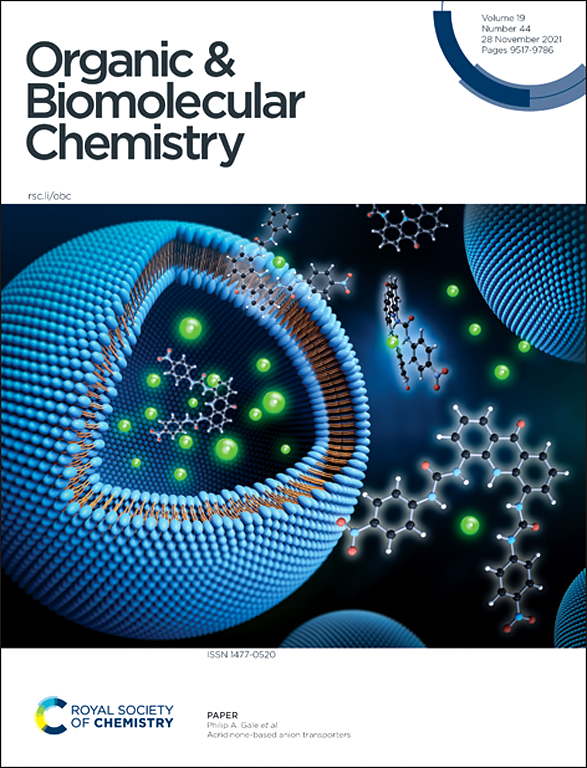Highly oxygenated steroids with immunosuppressive activity from Solanum undatum†
IF 2.9
3区 化学
Q1 CHEMISTRY, ORGANIC
引用次数: 0
Abstract
Solanum undatum is a medicinal plant used for the treatment of oedema, rheumatoid arthritis and toothache, from which seven highly oxygenated steroids (), including three new ones (), have been characterized. Compound is a new steroidal carboxylic acid featuring a cyclohexa-2,5-dien-1-one moiety and compounds and are new withanolide analogs with a 1,6-dimethyl-3,7-dioxabicyclo[4.1.0]heptan-2-ol terminus. Their structures and absolute configurations were determined by a combination of spectroscopic data, quantum chemical calculations, single-crystal X-ray diffraction, and the NMR-based phenylglycine methyl ester (PGME) method. An immunosuppressive activity assay revealed that compounds exhibited substantial activities against the proliferation of T and B lymphocytes in vitro, with IC50 values ranging from 1.60 to 7.89 μM and 0.90 to 6.90 μM, respectively. Notably, compound showed selective inhibitory effect toward B cells with the highest selective index (SI = 40.5). Preliminary structure–activity relationships of compounds suggest that the terminal 1,6-dimethyl-3,7-dioxabicyclo[4.1.0]heptan-2-ol or 5,5-spiroacetal moiety is critical for immunosuppressive activity. Our study indicated that they could be promising lead compounds for immunosuppressive agents.

来自 Solanum undatum 的具有免疫抑制活性的高含氧类固醇。
Solanum undatum 是一种用于治疗水肿、类风湿性关节炎和牙痛的药用植物,从这种植物中研究出了七种高含氧类固醇(1-7),其中包括三种新的类固醇(1-3)。化合物 1 是一种具有环己-2,5-二烯-1-酮分子的新型甾体羧酸,化合物 2 和 3 是具有 1,6-二甲基-3,7-二氧杂环二环[4.1.0]庚-2-醇末端的新的含钒内酯类似物。它们的结构和绝对构型是通过光谱数据、量子化学计算、单晶 X 射线衍射和基于核磁共振的苯甘氨酸甲酯(PGME)法综合确定的。免疫抑制活性测定显示,化合物 2-7 在体外对 T 淋巴细胞和 B 淋巴细胞的增殖具有很强的活性,IC50 值分别为 1.60 至 7.89 μM 和 0.90 至 6.90 μM。值得注意的是,化合物 6 对 B 细胞具有选择性抑制作用,选择性指数最高(SI = 40.5)。化合物 1-7 的初步结构-活性关系表明,末端的 1,6-二甲基-3,7-二氧杂环[4.1.0]庚-2-醇或 5,5-螺缩醛分子对免疫抑制活性至关重要。我们的研究表明,它们可能是很有前途的免疫抑制剂先导化合物。
本文章由计算机程序翻译,如有差异,请以英文原文为准。
求助全文
约1分钟内获得全文
求助全文
来源期刊

Organic & Biomolecular Chemistry
化学-有机化学
CiteScore
5.50
自引率
9.40%
发文量
1056
审稿时长
1.3 months
期刊介绍:
Organic & Biomolecular Chemistry is an international journal using integrated research in chemistry-organic chemistry. Founded in 2003 by the Royal Society of Chemistry, the journal is published in Semimonthly issues and has been indexed by SCIE, a leading international database. The journal focuses on the key research and cutting-edge progress in the field of chemistry-organic chemistry, publishes and reports the research results in this field in a timely manner, and is committed to becoming a window and platform for rapid academic exchanges among peers in this field. The journal's impact factor in 2023 is 2.9, and its CiteScore is 5.5.
 求助内容:
求助内容: 应助结果提醒方式:
应助结果提醒方式:


